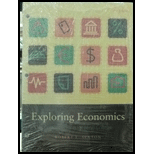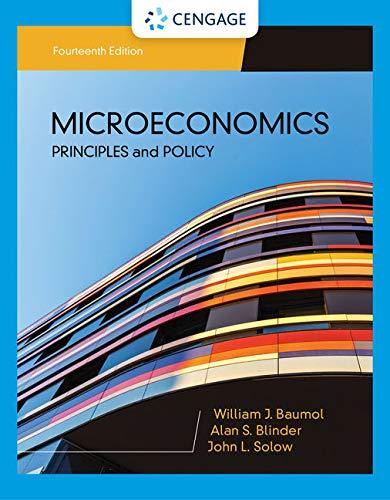
(a)
The marginal product of hat in the cases with three and four machines is to be determined.
Answer to Problem 5P
The marginal product of hat in the cases with three and four machines are shown below:
| Labor (L) | Total Product (TP) | Marginal Product (MP) |
| 1 | 8 | 8 |
| 2 | 18 | 10 |
| 3 | 30 | 12 |
| 4 | 45 | 15 |
| 5 | 57 | 12 |
| 6 | 67 | 10 |
| 7 | 72 | 5 |
| Labor (L) | Total Product (TP) | Marginal Product (MP) |
| 1 | 9 | 9 |
| 2 | 20 | 11 |
| 3 | 35 | 15 |
| 4 | 55 | 20 |
| 5 | 76 | 21 |
| 6 | 88 | 12 |
| 7 | 95 | 7 |
Explanation of Solution
Marginal Product is the addition to total product when an extra unit of labor is employed. It is calculated as follows.
Using the formula above, we calculate MP for 1st level of employment as follows:
Similarly, we calculate MP for each level of employment in cases with three and four machines and MP schedule for both cases is shown below.
| Labor (L) | Total Product (TP) | Marginal Product (MP) |
| 1 | 8 | 8 |
| 2 | 18 | 10 |
| 3 | 30 | 12 |
| 4 | 45 | 15 |
| 5 | 57 | 12 |
| 6 | 67 | 10 |
| 7 | 72 | 5 |
| Labor (L) | Total Product (TP) | Marginal Product (MP) |
| 1 | 9 | 9 |
| 2 | 20 | 11 |
| 3 | 35 | 15 |
| 4 | 55 | 20 |
| 5 | 76 | 21 |
| 6 | 88 | 12 |
| 7 | 95 | 7 |
Total Product (TP):
Total product is the total output that a firm produces by its production activities.
Marginal Product (MP):
Marginal Product is the addition to total product when an extra unit of a particular quantity.
(b)
The points at which the diminishing marginal product sets in with three machines and with four machines.
Answer to Problem 5P
The diminishing marginal product sets in with three machines at 5th level of labor employment. The diminishing marginal product sets in with four machines at 6th level of labor employment.
Explanation of Solution
We have the TP and MP schedule for the cases with three machines and four machines as follows:
| Labor (L) | Total Product (TP) | Marginal Product (MP) |
| 1 | 8 | 8 |
| 2 | 18 | 10 |
| 3 | 30 | 12 |
| 4 | 45 | 15 |
| 5 | 57 | 12 |
| 6 | 67 | 10 |
| 7 | 72 | 5 |
| Labor (L) | Total Product (TP) | Marginal Product (MP) |
| 1 | 9 | 9 |
| 2 | 20 | 11 |
| 3 | 35 | 15 |
| 4 | 55 | 20 |
| 5 | 76 | 21 |
| 6 | 88 | 12 |
| 7 | 95 | 7 |
In the first case, marginal product starts to fall from L=5. While, in the second case, marginal product starts to fall from L=6. Therefore, the diminishing marginal product sets in with three machines at 5th level of labor employment and diminishing marginal product sets in with four machines at 6th level of labor employment.
Total Product (TP):
Total product is the total output that a firm produces by its production activities.
Marginal Product (MP):
Marginal Product is the addition to total product when an extra unit of a particular quantity.
(c)
The reasons why the points of diminishing marginal product are different in the two cases.
Explanation of Solution
Marginal Product is the addition to total product when an extra unit of labor is employed. Typically, marginal product first increases, reaches maximum, falls and finally becomes negative. In both the cases, the property of marginal product applies. However, the falling of marginal product is delayed with four machines because increasing one input (labor) with increase in another input (machines) makes marginal product higher. The marginal product of labor is higher at each step with four machines than that with three machines. Thus, with more number of machines, the diminishing returns to labor set in at a later stage. Therefore, the points of diminishing marginal product are different in the two cases.
Total Product (TP):
Total product is the total output that a firm produces by its production activities.
Marginal Product (MP):
Marginal Product is the addition to total product when an extra unit of a particular quantity.
Want to see more full solutions like this?
Chapter 11 Solutions
EXPLORING ECON.-W/ACCESS (LL) >CUSTOM<
- Use the Feynman technique throughout. Assume that you’re explaining the answer to someone who doesn’t know the topic at all. Write explanation in paragraphs and if you use currency use USD currency: 10. What is the mechanism or process that allows the expenditure multiplier to “work” in theKeynesian Cross Model? Explain and show both mathematically and graphically. What isthe underpinning assumption for the process to transpire?arrow_forwardUse the Feynman technique throughout. Assume that you’reexplaining the answer to someone who doesn’t know the topic at all. Write it all in paragraphs: 2. Give an overview of the equation of exchange (EoE) as used by Classical Theory. Now,carefully explain each variable in the EoE. What is meant by the “quantity theory of money”and how is it different from or the same as the equation of exchange?arrow_forwardZbsbwhjw8272:shbwhahwh Zbsbwhjw8272:shbwhahwh Zbsbwhjw8272:shbwhahwhZbsbwhjw8272:shbwhahwhZbsbwhjw8272:shbwhahwharrow_forward
- Use the Feynman technique throughout. Assume that you’re explaining the answer to someone who doesn’t know the topic at all:arrow_forwardUse the Feynman technique throughout. Assume that you’reexplaining the answer to someone who doesn’t know the topic at all: 4. Draw a Keynesian AD curve in P – Y space and list the shift factors that will shift theKeynesian AD curve upward and to the right. Draw a separate Classical AD curve in P – Yspace and list the shift factors that will shift the Classical AD curve upward and to the right.arrow_forwardUse the Feynman technique throughout. Assume that you’re explaining the answer to someone who doesn’t know the topic at all: 10. What is the mechanism or process that allows the expenditure multiplier to “work” in theKeynesian Cross Model? Explain and show both mathematically and graphically. What isthe underpinning assumption for the process to transpire?arrow_forward
- Use the Feynman technique throughout. Assume that you’re explaining the answer to someone who doesn’t know the topic at all: 15. How is the Keynesian expenditure multiplier implicit in the Keynesian version of the AD/ASmodel? Explain and show mathematically. (note: this is a tough one)arrow_forwardUse the Feynman technique throughout. Assume that you’re explaining the answer to someone who doesn’t know the topic at all: 13. What would happen to the net exports function in Europe and the US respectively if thedemand for dollars rises worldwide? Explain why.arrow_forward20. Given the mathematical model below, solve for the expenditure multiplier for a) government spending, G; and b) for consumer taxes, T. (medium difficulty) Y=C+I+G C=Co+b(Y-T) 1 = 10 T=To+tY G = Go+gYarrow_forward
- Use the Feynman technique throughout. Assume that you’re explaining the answer to someone who doesn’t know the topic at all: 11. What exactly is a rectangular hyperbola and what relevance is it to classical economics?arrow_forwardUse the Feynman technique throughout. Assume that you’re explaining the answer to someone who doesn’t know the topic at all: 9. Explain the difference between absolute and comparative advantage in a family setting, i.e.using parents and children. What can we glean from knowing about comparative andabsolute advantages?arrow_forwardUse the Feynman technique throughout. Assume that you’re explaining the answer to someone who doesn’t know the topic at all: 18. Explain why most economists believe it is absolutely necessary to allow free trade in aneconomy. Why is it harmful (under most circumstances) to have tariffs and trade barriers?arrow_forward
 Exploring EconomicsEconomicsISBN:9781544336329Author:Robert L. SextonPublisher:SAGE Publications, Inc
Exploring EconomicsEconomicsISBN:9781544336329Author:Robert L. SextonPublisher:SAGE Publications, Inc Microeconomics: Private and Public Choice (MindTa...EconomicsISBN:9781305506893Author:James D. Gwartney, Richard L. Stroup, Russell S. Sobel, David A. MacphersonPublisher:Cengage Learning
Microeconomics: Private and Public Choice (MindTa...EconomicsISBN:9781305506893Author:James D. Gwartney, Richard L. Stroup, Russell S. Sobel, David A. MacphersonPublisher:Cengage Learning Economics: Private and Public Choice (MindTap Cou...EconomicsISBN:9781305506725Author:James D. Gwartney, Richard L. Stroup, Russell S. Sobel, David A. MacphersonPublisher:Cengage Learning
Economics: Private and Public Choice (MindTap Cou...EconomicsISBN:9781305506725Author:James D. Gwartney, Richard L. Stroup, Russell S. Sobel, David A. MacphersonPublisher:Cengage Learning Microeconomics: Principles & PolicyEconomicsISBN:9781337794992Author:William J. Baumol, Alan S. Blinder, John L. SolowPublisher:Cengage Learning
Microeconomics: Principles & PolicyEconomicsISBN:9781337794992Author:William J. Baumol, Alan S. Blinder, John L. SolowPublisher:Cengage Learning Economics (MindTap Course List)EconomicsISBN:9781337617383Author:Roger A. ArnoldPublisher:Cengage Learning
Economics (MindTap Course List)EconomicsISBN:9781337617383Author:Roger A. ArnoldPublisher:Cengage Learning





